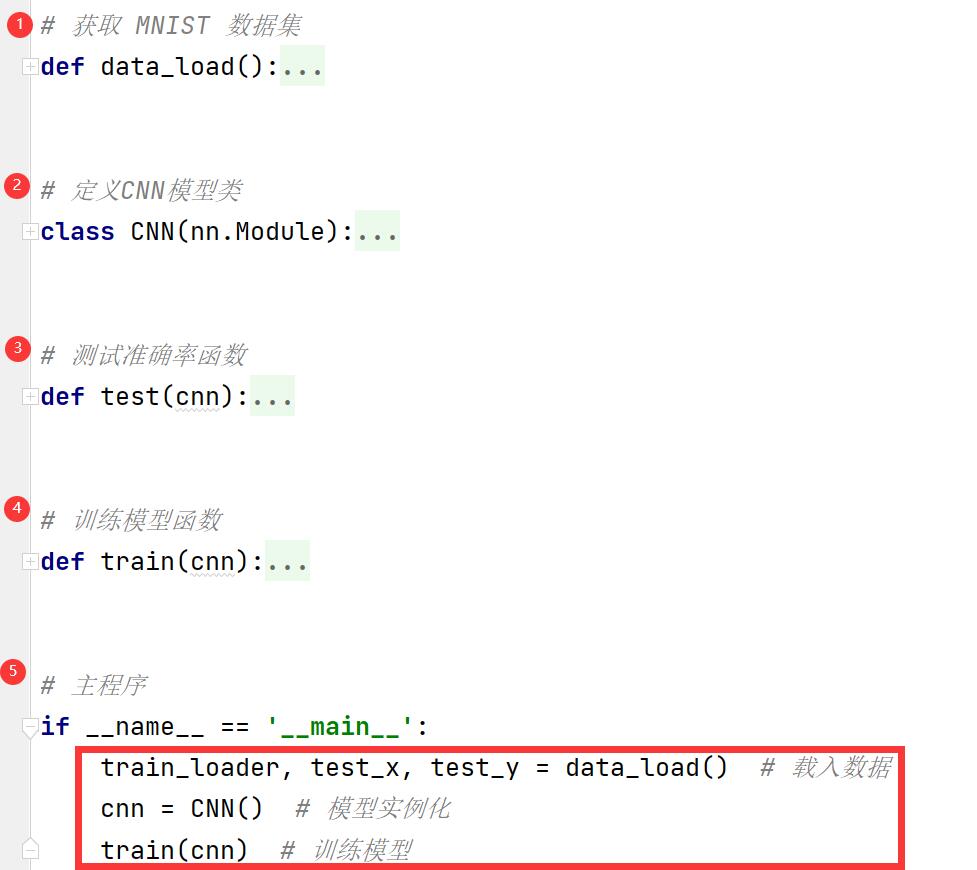邱老师出题为填空题,填空比较容易完成。
做完之后,需要通读源代码。
每一个函数、每一行代码,都不应有存疑之处,将来才可以根据这个例子做自己的CNN。
程序结构:

加完整注释的源代码:
# https://www.cnblogs.com/douzujun/p/13454960.html
import os
import torch
import torch.nn as nn
from torch.autograd import Variable
import torch.utils.data as Data
import torchvision
import torch.nn.functional as F
import numpy as np
learning_rate = 1e-4 # 学习率
keep_prob_rate = 0.7 # 丢弃率的函数参数
max_epoch = 1 # 训练轮次
BATCH_SIZE = 50 # 批 尺寸
# 获取 MNIST 数据集
def data_load():
DOWNLOAD_MNIST = False
if not (os.path.exists('./mnist/')) or not os.listdir('./mnist/'): # not mnist dir or mnist is empty dir
DOWNLOAD_MNIST = True
# 训练集load
train_data = torchvision.datasets.MNIST(root='./mnist/', train=True, transform=torchvision.transforms.ToTensor(),
download=DOWNLOAD_MNIST, )
train_loader = Data.DataLoader(dataset=train_data, batch_size=BATCH_SIZE, shuffle=True)
# 测试集load, test_x 图像, test_y 标签 。取了前500个测试数据。
test_data = torchvision.datasets.MNIST(root='./mnist/', train=False)
test_x = Variable(torch.unsqueeze(test_data.test_data, dim=1), volatile=True).type(torch.FloatTensor)[:500] / 255.
test_y = test_data.test_labels[:500].numpy()
return train_loader, test_x, test_y
# 定义CNN模型类
class CNN(nn.Module):
def __init__(self):
super(CNN, self).__init__()
self.conv1 = nn.Sequential( # 序列容器,层是有序的,严格按照顺序执行,相邻两层连接必须保证前一层的输出与后一层的输入匹配。
nn.Conv2d(in_channels=1, out_channels=32, kernel_size=7, stride=1, padding=0, ),
# 卷积 (输入通道, 输出通道, 卷积核尺寸, 步长, 填充)
nn.ReLU(), # 激活
nn.MaxPool2d(2), # 池化
)
self.conv2 = nn.Sequential(
nn.Conv2d(in_channels=32, out_channels=64, kernel_size=5, stride=1, padding=0, ), # 卷积
nn.ReLU(), # 激活
nn.MaxPool2d(1), # 池化
)
self.out1 = nn.Linear(7 * 7 * 64, 1024, bias=True) # 全连接层
self.dropout = nn.Dropout(keep_prob_rate) # 丢弃法 防止过拟合
self.out2 = nn.Linear(1024, 10, bias=True) # 全连接层
def forward(self, x): # 前向传播
x = self.conv1(x)
x = self.conv2(x)
x = x.view(-1, 64 * 7 * 7) # 重构张量的维度。 flatten the output of conv2 to (batch_size ,64 * 7 * 7)
out1 = self.out1(x)
out1 = F.relu(out1)
out1 = self.dropout(out1)
out2 = self.out2(out1)
output = F.softmax(out2)
return output
# 测试准确率函数
def test(cnn):
global prediction
y_pre = cnn(test_x) # 求预测值 (数值为概率)
# print(y_pre)
_, pre_index = torch.max(y_pre, 1) # 找 最大预测值的 索引号 (数值为整数)
pre_index = pre_index.view(-1) # 索引号 = 概率最大的那个数字的位置。因此,这个索引号就是预测的数字。
# print(pre_index)
prediction = pre_index.data.numpy() # torch convert to numpy
correct = np.sum(prediction == test_y) # 如果 预测值 = 标签 ,correct 加 1
# print(len(test_x)) # 测试集 大小 = 500
return correct / 500.0 # 正确的预测数 / 测试集总数 = 正确率
# 训练模型函数
def train(cnn):
optimizer = torch.optim.Adam(cnn.parameters(), lr=learning_rate) # 优化器Adam
loss_func = nn.CrossEntropyLoss() # 交叉熵误差
for epoch in range(max_epoch):
for step, (x_, y_) in enumerate(train_loader):
x, y = Variable(x_), Variable(y_) # 输入值; 标签值
output = cnn(x) # output:预测值
loss = loss_func(output, y) # 计算交叉熵误差
optimizer.zero_grad() # 梯度清零
loss.backward() # 反向传播
optimizer.step() # 参数优化
if step != 0 and step % 100 == 0:
print("=" * 10, step, "=" * 5, "=" * 5, "test accuracy is ", test(cnn), "=" * 10)
print("train finished !")
# 主程序
if __name__ == '__main__':
train_loader, test_x, test_y = data_load() # 载入数据
cnn = CNN() # 模型实例化
train(cnn) # 训练模型